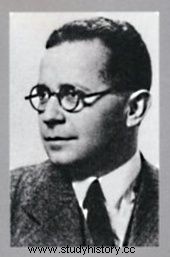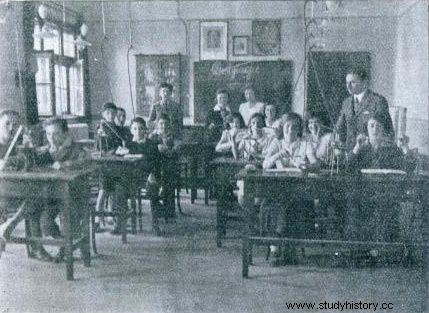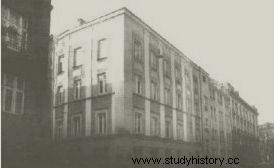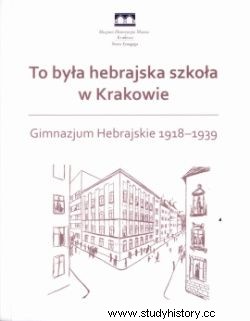What were the pre-war schools like? What were they taught and who were the teachers of that time? You can write about it on various examples, but a particular high school in Kraków seems to be particularly interesting (and unusual). Undoubtedly an elite school, but also ... not intended for everyone. For although Polish was taught and patriotism instilled in it, it was nevertheless a Jewish school.
When in 1913 the members of the Chowa Syjon society began to work on the construction of the Hebrew Gymnasium on the corner of Brzozowa and Podbrzezie streets, they did not even guess how many outstanding graduates would leave its walls. It was here that the Israeli Walt Disney, i.e. Józef Bauk, the school doctor and skilled educator of Israeli youth Igo Feldblum, or the director, journalist, writer and film historian, Natan Gross, was educated. All of them and many others started modestly and, as they emphasized in their memoirs, it was the Hebrew Gymnasium that led them to the people. Unfortunately, it is difficult to say the same about lower secondary schools today. Lack of control, buzzing hormones and ignoring all authority. In a word, a mess. And it used to be so beautiful…
Polish speech is not such a difficult language
To find out what it looked like in practice before the war, we need to take a good example. And for this we will serve the already mentioned Hebrew Gymnasium in Krakow. As one of the school's graduates Miriam Gobernik tells, quoted in the book “It was a Hebrew school in Krakow. Hebrew Gymnasium 1918-1939 ”:
Our Hebrew Gymnasium was a great school and at a high level. The teachers were very intelligent! They were young people, and if it weren't for the difficulties, if not for deep anti-Semitism in society, they could be academic lecturers. We had excellent teachers who influenced our lives.

Juliusz Feldhorn, one of the teachers of the gymnasium in Brzozowa Street. By the way, a whole separate book was written about him ...
Yes, definitely this school has become excellent educators. We will not cover all the lecturers here. We will use an interesting example again.
The Polish language was taught there by Juliusz Feldhorn, a humanist in the full sense of the word. Translator from Hebrew, German and Italian, writer, historian of literature and art, poet and music lover. A real omnibus! His students recall that the lessons with him were a celebration. On the other hand, as Justyna Kozioł-Marzec, the co-author of the book mentioned above, writes, The students loved Feldhorn and were afraid of him like fire. [...] He showed his students the beauty of Polish prose and poetry in an unforgettable way, but he did not stop at his native literature. Today, in the era of the crazy pace of implementation of the core curriculum, one can only dream of conducting lessons in such a way ...
Missing assumptions?
The Hebrew Gymnasium actually had two purposes. Firstly, it was supposed to educate young people in the spirit of patriotism and civic attitudes (Polish ones!), And secondly, to spread Jewish national values. It would seem that these assumptions were mutually exclusive. Nothing could be more wrong. The school skilfully combined them, thanks to which its walls were left by nationally aware Jews, who were faithful citizens of the Most Serene Republic of Poland.
Incidentally, it should also be mentioned that in order to implement the second assumption, a whole separate subject block was created. It included learning Hebrew, the Bible and religion. Special teachers were employed at the Gymnasium to teach these subjects. In addition to regular school activities, important Jewish holidays were celebrated at school, culture was promoted, services were held in the school synagogue, and some lecturers prepared students for the bar mitzvah.

This, in turn, was what the classes in pre-war schools looked like…
Because it's fun to make music
The school choir was the realm of Baruch Sperber. 60 students trained their vocal talents under his watchful eye, or rather ear. In order to be able to add splendor to school celebrations, patriotic evening parties or religious holidays, young people exercised for two hours a week. The choirmaster was downright ruthless with those who couldn't sing like nightingales. Gustawa Stendig-Lindberg recalls: I only felt sorry with the singing teacher, because he wouldn't let me sing. [...] said "Stendig, you spoil the whole choir" and told me to leave the classroom.

… And this in turn is the building of the school itself.
Not only Baruch Sperber and his choristers did the notes. In the school year 1933/1934 a music club was established. It took place between organizing programs for school students and expanding musical knowledge thanks to meetings with real musicians.
There was also a brass band in the school, led by Ozjasz Mahler in cooperation with professionals. Her rehearsals took place twice a week and lasted two hours.
In the circle of circles
During the entire interwar period, there were many interest clubs in the Hebrew Gymnasium. Within them, students were grouped by age, and classes were held approximately once a week.
As part of the biology club, students prepared herbariums, grew plants, completed zoological collections, exercised with a microscope, etc. Rachel Goldwasserowa, who lectured in natural science and geography, dealt with this circle. In the school year 1933/1934, the Circle of Young Friends of Animals emerged from its composition.
The mathematics club carried out content that definitely went beyond the gymnasium curriculum. In addition to discussing various mathematical problems with the students, the tutors even organized a special descriptive geometry course for them . The chemical circle tried to show the practical dimension of its everyday life. Among other things, it was possible to organize two lectures by the head of the department of general chemistry of the agricultural college of the Jagiellonian University. The students also visited various production plants, including an oil refinery and a soap factory . Moreover, they organized a specialist library, which teachers also used during lessons.

"What children learned ..." is another article published by us in cooperation with the Historical Museum of the City of Krakow. Fans of the Second Polish Republic are invited to read the museum publication "It was Hebrew ..." and to visit the Old Synagogue in Krakow. For two more weeks, you can visit the exhibition devoted to the Hebrew gymnasium.
Interest groups related to the humanities disciplines were equally dynamic. As part of his circle, Feldhorn deepened the literary knowledge of his students. Löw successfully ran a drama circle, staging plays on various occasions and deepening the knowledge of various literary works. It could be described endlessly like this:a Germanic circle, a philosophical, philological, historical circle… Well, today hardly any school can boast a similar number of extracurricular activities. It is even more rare for them to be conducted with such verve and the equal commitment of the students. Well, I don't know about you, but I didn't go on a trip to a soap factory from my junior high school ...
Beautiful testimony
Goodbye a few more words about the end of the Hebrew Gymnasium. When the Germans invaded Poland in 1939, it was a real shock for many. It was similar with the teachers and students of this school, who, however, quickly shook off it. Soon lessons were quietly resumed in the Gymnasium building and continued as long as possible . In the meantime, more and more people were disappearing, more and more were starving, but sitting in hastily organized school benches gave them an appearance of normalcy. Only a handful of students survived the Holocaust and, thanks to the careful education they received in Krakow, became part of Israel's intellectual elite.
Source:
- Maciej W. Belda, Piotr Figiela, Justyna Kozioł-Marzec and others, It was a Hebrew school in Krakow. Hebrew Gymnasium 1918-1939 , Historical Museum of the City of Kraków, 2011.
